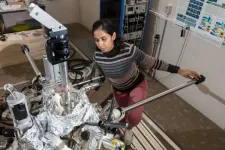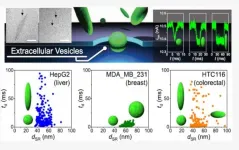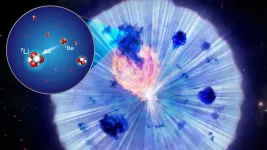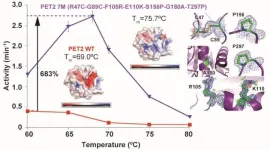Researchers identify ultrastable single atom magnet
2021-07-07
(Press-News.org) Researchers at the IBS Center for Quantum Nanoscience at Ewha Womans University (QNS) have shown that dysprosium atoms resting on a thin insulating layer of magnesium oxide have magnetic stability over days. In a study published in Nature Communications they have proven that these tiny magnets have extreme robustness against fluctuations in magnetic field and temperature and will flip only when they are bombarded with high energy electrons through the STM-tip.
Using these ultra-stable and yet switchable single-atom magnets, the team has shown atomic-scale control of the magnetic field within artificially built quantum architectures. "The atomic scale tunability and precision engineering of magnetic fields shown in this work adds a new paradigm for quantum logic devices and quantum computation." says Dr Aparajita Singha who conducted the research as a post doc at QNS and is now a group leader at the Max Planck Institute for Solid State Research.
Although magnetism arises at the level of single atoms, also called unpaired spins, small atomic clusters are generally magnetically very unstable without careful control of their surroundings. Understanding magnetic properties at such small scales is a fundamental physics problem, which has become technically very important for creating qubits - the building blocks for quantum computation.
Magnetism at such small scales can be studied and controlled using quantum tunneling through sharp electrode probes in a Scanning Tunneling Microscope (STM). The fingerprint of these atomic spins can be measured using single-atom electron spin resonance (ESR). The research team at QNS combined the use these powerful techniques to find the right conditions for achieving the long-sought robust single-atom magnet.
"Creating the smallest ultra-stable magnets was far from a small effort. It needed operating at the limits of measurement techniques and finding just the right conditions. On a double-layer MgO substrate, the Dy atom is almost isolated but still feels enough directionality to maintain a defined polarity over days," according to Dr. Singha.
To be able to freeze single atoms and measure their miniscule signals, the team created an extreme physical environment, including: (a) temperatures 1000s of times smaller than room temperature, at which atoms stop drifting on surfaces, (b) vacuum stronger than empty space, so that atoms do not get contaminated by impurities which would otherwise bias our results, and (c) ultraclean crystalline surfaces with almost nothing on top other than the desired single atoms. As for the tool itself, they picked up single Fe (iron) atoms one-by-one on the STM-tip until achieving enough signal-to-noise ratio in ESR, even in absence of any external magnetic field (generally 30-50 atoms). Since the electronic states of an ultrastable Dy-atom magnets (4f orbitals) are too shielded for STM measurements, the researchers measured its magnetic field projection on a more easily measurable sensor Fe-atom, placed at defined locations on the same surface. Using the same STM-tip, they also arranged single Dy-atom magnets at different lattice locations of the crystalline substrate around the sensor Fe-atom. Deliberate flipping of the individual Dy-atom magnets changed the magnetic field at the sensor Fe-atom location with precise discreteness, which was then measured to be stable over days using ESR.
Switchable ultrastable single-atom magnets placed at atomically precise locations provide a toolbox for extremely local but precise control of magnetic fields. Once the magnetic state is set, it is maintained automatically without any need of huge and expensive external magnets. Dr. Singha concluded that, "the atomic-scale tunability of magnetic field is a powerful control tool for future surface-based quantum circuits."
INFORMATION:
[Attachments] See images for this press release:

ELSE PRESS RELEASES FROM THIS DATE:
2021-07-07
Dr Bock, under the mentorship of Distinguished Professor Dietmar Hutmacher, from QUT Centre for Biomedical Technologies, has focused her research on bone metastases from breast and prostate cancers.
She developed 3D miniature bone-like tissue models in which 3D printed biomimetic scaffolds are seeded with patient-derived bone cells and tumour cells to be used as clinical and preclinical drug testing tools.
The research team investigated their hypothesis that traditional anti-androgen therapy had limited effect in the microenvironment of prostate cancer bone tumours. The team's findings are published in Science Advances.
"We wanted to see if the therapy could be a contributor of cancer cells' adaptive responses that fuelled bone ...
2021-07-07
A recent study by scientists from Japanese universities has shown that the shape of cell-derived nanoparticles, known as "extracellular vesicles" (EVs), in body fluids could be a biomarker for identifying types of cancer. In the study, the scientists successfully measured the shape distributions of EVs derived from liver, breast, and colorectal cancer cells, showing that the shape distributions differ from one another. The findings were recently published in the journal Analytical Chemistry.
Early detection of cancerous tumors in the body is essential for ...
2021-07-07
New York, NY (July 6, 2021) - Mount Sinai researchers have uncovered the complex cellular mechanisms of Ebola virus, which could help explain its severe toll on humans and identify potential pathways to treatment and prevention. In a study published in mBio, the team reported how a protein of the Ebola virus, VP24, interacts with the double-layered membrane of the cell nucleus (known as the nuclear envelope), leading to significant damage to cells along with virus replication and the propagation of disease.
"The Ebola virus is extremely skilled at dodging the body's immune defenses, and in our study we characterize an important way in which that evasion occurs through disruption of the nuclear envelope, mediated by the VP24 protein," says co-senior ...
2021-07-07
QUT PhD researcher Zachariah Schuurs said the research team had identified a new binding site on the SARS-CoV-2 spike protein.
"Binding of the CoV-2 spike protein to heparan sulphate (HS) on cell surfaces is generally the first step in a cascade of interactions the virus needs to initiate an infection and enter the cell.
"Most research has focused on understanding how HS interacts on the receptor-binding domain (RBD) and furin cleavage site of the SARS-CoV-2 virus's spike protein, as these typically bind different types of drugs, vaccines and antibodies.
"We have identified a novel binding site on the N-terminal domain (NTD), a different area of the virus's spike that facilitates the binding of HS. This helps to better understand how the virus ...
2021-07-07
A new study of lithium production in a classical nova found a production rate of only a couple of percent that seen in other examples. This shows that there is a large diversity within classical novae and implies that nova explosions alone cannot explain the amount of lithium seen in the current Universe. This is an important result for understanding both the explosion mechanism of classical novae and the overall chemical evolution of the Universe.
In the modern world, lithium is used in the rechargeable batteries powering smartphones and other devices. ...
2021-07-07
Cheap to produce and long to degrade, plastic was once a manufacturing miracle. Now, plastic is an environmental plague, clogging landfills and choking waterways. A Japan-based research team has turned back to nature to develop an approach to degrading the stubborn substance. Similar to how a protein binds to cellulose in plants or to chitin in crustaceans to initiate decomposition, an engineered protein is on its way to binding to plastic particles in an effort to more efficiently break them down.
They published their results on June 29 in ACS Catalysis, a journal of the American Chemical Society.
"Polyethylene ...
2021-07-07
In two recent articles published in Schizophrenia Bulletin, Sharon Hunter, PhD, an associate professor in the University of Colorado School of Medicine Department of Psychiatry, and M. Camille Hoffman, MD, MSc, an associate professor in the University of Colorado School of Medicine Department of Obstetrics and Gynecology, along with their research group, have uncovered a potential link between choline deficiency in Black pregnant women in the United States and increased risk of developmental and behavioral issues that can evolve into mental illness later in their children's lives.
The first article, published in November 2020, is a study, titled, "Black American Maternal Prenatal Choline, Offspring Gestational Age at Birth, and Developmental Predisposition to Mental Illness." The ...
2021-07-07
Scientists at KAIST have fabricated a laser system that generates highly interactive quantum particles at room temperature. Their findings, published in the journal Nature Photonics, could lead to a single microcavity laser system that requires lower threshold energy as its energy loss increases.
The system, developed by KAIST physicist Yong-Hoon Cho and colleagues, involves shining light through a single hexagonal-shaped microcavity treated with a loss-modulated silicon nitride substrate. The system design leads to the generation of a polariton laser at room temperature, which is exciting because this usually requires cryogenic temperatures.
The researchers found another unique and counter-intuitive feature of this design. Normally, energy is lost during laser operation. ...
2021-07-07
Australian scientists researching how our immune system responds to COVID-19 have revealed that those infected by early variants in 2020 produced sustained antibodies, however, these antibodies are not as effective against contemporary variants of the virus.
The research is one of the world's most comprehensive studies of the immune response against COVID-19 infection. It suggests vaccination is more effective than the body's natural immune response following infection and shows the need to invest in new vaccine designs to keep pace with emerging COVID variants.
Published today in PLOS ...
2021-07-07
Polymer composite materials that combine magnetic and electrical properties are the subjects of particular attention for modern-day researchers. Their basic property is the ability to convert electric polarization into a magnetic field and vice versa. Although some materials exhibit a much better magnetoelectric effect, polymer-based composites are easier not only to produce but also to modify.
Such composites have great potential in a variety of different fields. For example, using them as a basis, scientists can develop surfaces that help cultivate various cells. In this case, polymer composites serve as a substrate through which it is possible to affect the culture using a non-contact and controlled electric charge and morphological properties ...
LAST 30 PRESS RELEASES:
[Press-News.org] Researchers identify ultrastable single atom magnet





